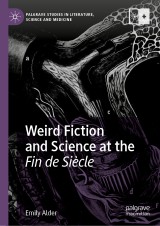Details

Weird Fiction and Science at the Fin de Siècle
Palgrave Studies in Literature, Science and Medicine
|
96,29 € |
|
| Verlag: | Palgrave Macmillan |
| Format: | |
| Veröffentl.: | 07.01.2020 |
| ISBN/EAN: | 9783030326524 |
| Sprache: | englisch |
Dieses eBook enthält ein Wasserzeichen.
Beschreibungen
<p>This book explores how nineteenth-century science stimulated the emergence of weird tales at the <i>fin de siècle</i>, and examines weird fiction by British writers who preceded and influenced H. P. Lovecraft, the most famous author of weird fiction. From laboratory experiments, thermodynamics, and Darwinian evolutionary theory to psychology, Theosophy, and the ‘new’ physics of atoms and forces, science illuminated supernatural realms with rational theories and practices. Changing scientific philosophies and questioning of traditional positivism produced new ways of knowing the world—fertile borderlands for fictional as well as real-world scientists to explore. Reading Robert Louis Stevenson’s <i>Strange Case of Dr Jekyll and Mr Hyde</i> (1886) as an inaugural weird tale, the author goes on to analyse stories by Arthur Machen, Edith Nesbit, H. G. Wells, William Hope Hodgson, E. and H. Heron, and Algernon Blackwood to show how this radical fantasy mode can be scientific, and how sciences themselves were often already weird.</p>
<div>Chapter 1: Weird tales and scientific borderlands at the <i>fin de siècle</i>.- Part I: Borderlands of Mind, Body, and Spirit.- Chapter2: Weird selves, weird worlds: psychology, ontology, and states of mind in Robert Louis Stevenson and Arthur Machen.- Chapter 3: Weird knowledge: experiments, senses, and epistemology in Stevenson, Machen, and Nesbit.- Chapter 4: Weirdfinders: reality, mastery, and the occult in E. and H. Heron, Algernon Blackwood, and William Hope Hodgson.- Part II: Borderlands of Time, Place, and Matter.- Chapter 5: Meat and mould: the weird creatures of William Hope Hodgson and H. G. Wells.- Chapter 6: Weird energies: physics, futures, and the secrets of the universe in Hodgson and Blackwood.</div><div><br></div>
<p>Dr Emily Alder is Lecturer in Literature and Culture at Edinburgh Napier University in Scotland, UK, and a member of the RSE Young Academy of Scotland. She is Editor of the journal <i>Gothic Studies</i>, and co-editor of <i>Gothic Science Fiction, 1980–2010</i> (2011). This is her first book.</p>
<p>This book explores how nineteenth-century science stimulated the emergence of weird tales at the <i>fin de siècle</i>, and examines weird fiction by British writers who preceded and influenced H. P. Lovecraft, the most famous author of weird fiction. From laboratory experiments, thermodynamics, and Darwinian evolutionary theory to psychology, Theosophy, and the ‘new’ physics of atoms and forces, science illuminated supernatural realms with rational theories and practices. Changing scientific philosophies and questioning of traditional positivism produced new ways of knowing the world—fertile borderlands for fictional as well as real-world scientists to explore. Reading Robert Louis Stevenson’s <i>Strange Case of Dr Jekyll and Mr Hyde</i> (1886) as an inaugural weird tale, the author goes on to analyse stories by Arthur Machen, Edith Nesbit, H. G. Wells, William Hope Hodgson, E. and H. Heron, and Algernon Blackwood to show how this radical fantasy mode can be scientific, and how sciences themselves were often already weird.</p><p>Dr Emily Alder is Lecturer in Literature and Culture at Edinburgh Napier University in Scotland, UK, and a member of the RSE Young Academy of Scotland. She is Editor of the journal <i>Gothic Studies</i>, and co-editor of <i>Gothic Science Fiction, 1980–2010</i> (2011). This is her first book.<br></p><p><br></p><p></p><p>This essential book combines astute literary analysis with scientific historicism, making an important case for the need to read speculative realism through nineteenth-century developments in biology, physics, psychology and spiritualism. Rather than reduce the work of key exponents like H. P. Lovecraft, Algernon Blackwood, Edith Nesbit or William Hope Hodgson to a mere cultural mirror, Alder shows how both science and weird fiction need to be understood as comparable responses to significant changes in conceptions of time, space and being that shaped the modern world. </p>
<p><br> Xavier Aldana Reyes, Reader in English Literature and Film, Manchester Metropolitan University</p>
<p><br></p>
<p><br></p><br><p></p>
<p><br> Xavier Aldana Reyes, Reader in English Literature and Film, Manchester Metropolitan University</p>
<p><br></p>
<p><br></p><br><p></p>
Explores how nineteenth-century science stimulated the emergence of weird tales at the fin de siècle Examines weird fiction by British writers who preceded and influenced H. P. Lovecraft Shows how this radical fantasy mode can be scientific Explains how sciences themselves were often already weird
Diese Produkte könnten Sie auch interessieren:

The Enigma of Good and Evil: The Moral Sentiment in Literature

von: Anna-Teresa Tymieniecka

309,23 €















